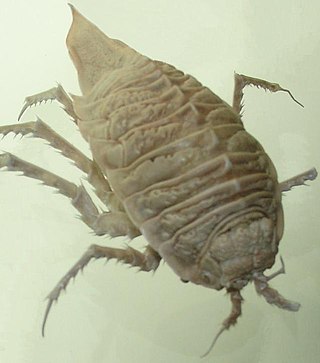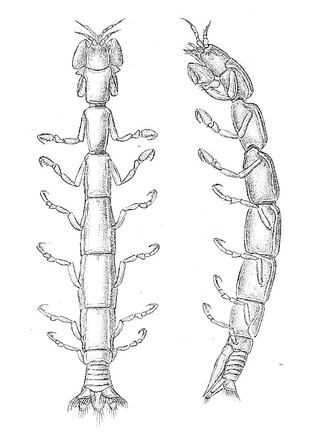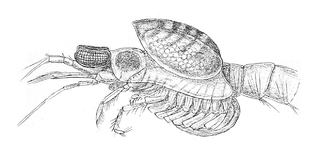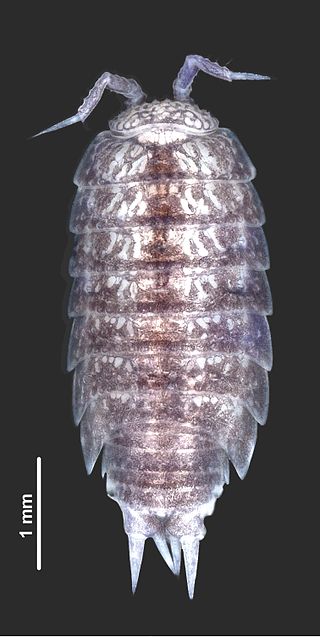
The Valvifera are marine isopod crustaceans. Valviferans are distinguished, however, by the flat, valve-like uropods which hinge laterally and fold inward beneath the rear part of their bodies, covering the pleopods. Some species are omnivorous, and serve as effective scavengers in the economy of the sea.

Sphaeromatidae is a family of isopods, often encountered on rocky shores and in shelf waters in temperate zones. The family includes almost 100 genera and 619 known marine species. Within these genera, there are groups that share distinctive morphologies; further research may reclassify these genus-groups as separate families.
Amphoroidea is a genus of isopod of the family Sphaeromatidae, containing the following species:
Curassanthura is a genus of isopod crustaceans in the family Leptanthuridae. It contains the following species:
Onchotelson is a genus of isopod crustaceans in the family Phreatoicidae, which is endemic to Tasmania. It contains two species, both of which are listed as vulnerable on the IUCN Red List:
Iais is a genus of isopod crustaceans. Iais species are found in association with larger isopods of the family Sphaeromatidae, usually on the ventral surface of the larger animal, between the pereiopods and on the pleopods. They are native to Australasia and South America, although Iais californica and its host Sphaeroma quoyanum have invaded California, and I. californica was first described from Sausalito, California. Nine species are recognised:

The Idoteidae are a family of isopod crustaceans. It includes these genera:

The Cirolanidae are a family of isopod crustaceans, including these genera:

Paracerceis is a genus of isopod crustacean in the family Sphaeromatidae. It contains the following species:

The Leptanthuridae are a family of isopod crustaceans, containing the following genera:

Cymothoida is the name of a suborder of isopod crustaceans with a mostly carnivorous or parasitic lifestyle. It contains more than 2,700 described species in four superfamilies. Members of the suborder are characterised by their specialised mouthparts which include a mandible with a tooth-like process which is adapted for cutting or slicing.

Sphaeromatidea is a suborder of isopod crustaceans.

Gnorimosphaeroma is a genus of isopod crustaceans, containing the following species:

The Bopyridae are a family of isopod crustaceans in the suborder Cymothoida. There are 1223 individual species contained in this family. Members of the family are ectoparasites of crabs and shrimp. They live in the gill cavities or under the carapace where they cause a noticeable swelling. Fossil crustaceans have occasionally been observed to have a similar characteristic bulge.

Chiridotea is a genus of isopod crustaceans in the family Chaetiliidae, containing the following species:

Saduria is a genus of benthic isopod crustaceans in the family Chaetiliidae, containing the following species:

The Dajidae are a family of marine isopod crustaceans in the suborder Cymothoida. The original description was made by Giard and Bonnier in 1887. Members of this family are ectoparasites of krill. They resemble a fleshy growth on the krill's back, and make the host look as if it is wearing a rucksack. These genera are included in the family Dajidae:

The Entoniscidae are a family of marine isopod crustaceans in the suborder Cymothoida. Members of this family are parasites of brachyuran and anomuran crabs, living in their hosts' haemocoel. A small chitinised hole develops through the host's exoskeleton through which the isopod can communicate with the environment. The female isopod bears little resemblance to any free-living isopod, but the morphology of the larvae show their taxonomic affiliations.

Styloniscidae is a family of woodlice, including the following genera:

The Arcturidae are a family of marine isopod crustaceans in the suborder Valvifera. Members of the family resemble woodlice and are found globally in cooler areas in shallow seas.













